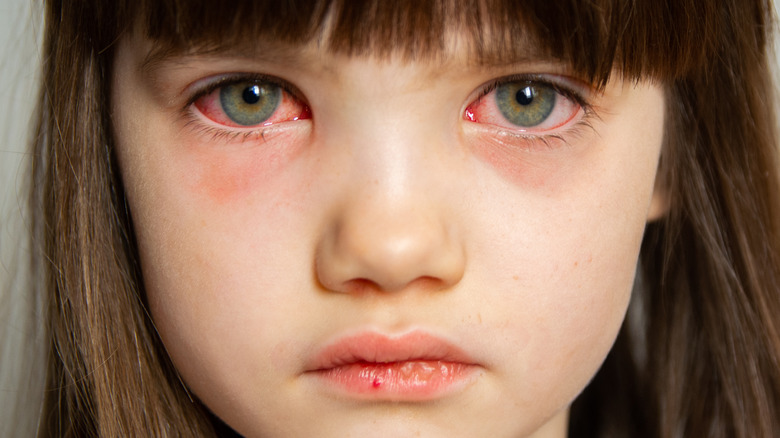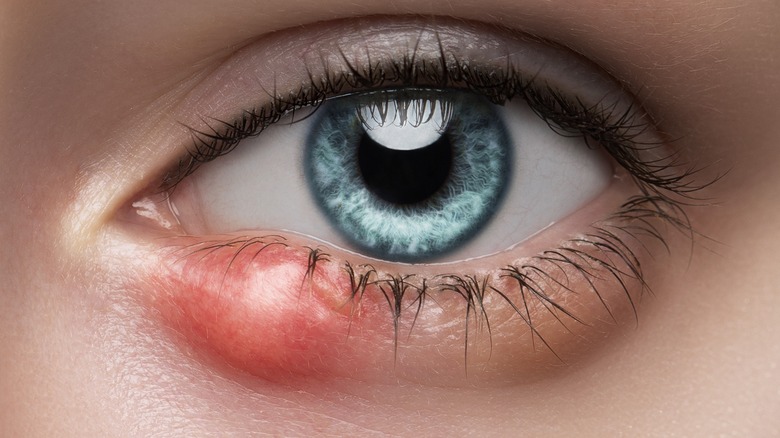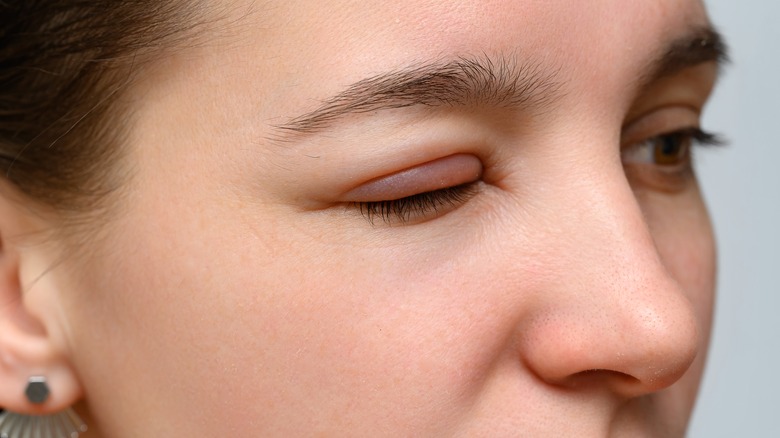What It Means If You Wake Up With One Eye Glued Shut
You woke up this morning and couldn't open your eye. After a moment of panic, you realized your eye was glued shut. The first thing to do when your eyes are stuck together is to grab a warm compress and slowly remove the crust that's sealing your eye shut rather than just forcing it open. Once you can see again, tracking the cause might take some sleuthing.
Sticky or crusty eyes can be common for those with colds or allergies. Your eyes might feel itchy and gritty, making you want to scratch and rub them. These conditions can cause your eyes to produce more discharge than average, which seals your eyes while you sleep (per Healthline). The stickiness could also be due to sleep crust, a normal protective barrier, states the American Academy of Ophthalmology (AAO). However, contact wearers can experience abnormal eye discharge from improperly cleaning their contacts or even accidentally wearing them to sleep.
Your eye feeling glued shut might also come from medical conditions like pinkeye, stye, tear duct infection, dry eye, or eyelid inflammation. Learning the symptoms and treatments for these conditions can help to ensure your eyes stay happy and healthy after a good night's sleep.
Pink eye can leave your eye sticky
Waking up with an eye that's crusted shut can be beyond annoying, but think twice before you rub it. You could have contracted pink eye, also known to the medical community as "conjunctivitis." This infection comes in three types: viral, bacterial, and allergic (per AAO). Viral and bacterial conjunctivitis are contagious, but allergic conjunctivitis isn't. Until you know what variety you have, keep your fingers away from your eyes. According to the Mayo Clinic, viral and bacterial conjunctivitis commonly occur along with a cold or respiratory tract infection.
Beyond just a crusty eye in the morning, symptoms include a gritty sensation; red eyes; itch, puffy eyelids; and discharge. The discharge can be so thick that your eyes and lashes can stick together. Sufferers also report burning, pain, and hazy vision.
Treatment depends on the type you've got. Viral and allergic conjunctivitis will clear up on their own over time, but drops can help with pain and puffiness. The bacterial form is typically treated with antibiotics. Over-the-counter meds are helpful for pain, and a warm compress on the eye can alleviate some swelling. Just remember to use a clean cloth for each treatment since both viral and bacterial conjunctivitis can spread.
A stye could cause your eye to be glued shut
Glued eye plus painful redness means you're probably dealing with a stye. According to Penn Medicine, a stye is an oil gland along the edge of your eyelid that's gotten inflamed due to a blockage. As with a pimple, junk, like dead skin and bacteria, can get in your oil gland. When the duct becomes blocked, inflammation and a sticky eye ensue. Thankfully, they also act like a pimple and typically heal and drain on their own. But they can irritate your eye with a gritty sensation, tenderness, and sensitivity to light until they do
A stye can be frustrating, but you never want to pop it. Instead, apply a warm compress several times a day, according to Healthline. You can also try gently cleaning your eyelids with a mild soap to remove all the junk. Taking over-the-counter medications like ibuprofen or acetaminophen may help provide relief from discomfort. Gently rubbing around your eye might help promote drainage. It's also essential to remove makeup and excess oil from your face and eyes to avoid a buildup. Avoid wearing contacts or applying makeup in the area until it has healed.
Call a doctor if you notice the stye is affecting your vision or getting worse rather than better after a week.
A blocked tear duct might be the culprit
You've probably noticed that you cry when you get a surge of emotion. Those tears spill from small ducts in the eyes, which can get blocked and infected, leading to you waking up with one eye glued shut. According to Harvard Health Publishing, infections of the tear ducts are typically due to infections from gunk getting caught in the duct. They also occur from getting hit in the eye or nose, which can cause inflammation. Tumors and certain drugs may play a role in this condition as well.
The Cleveland Clinic states that dacryocystitis, the medical term for tear duct inflammation or infection, comes in two forms. The acute form comes on suddenly and leaves just as quickly. The chronic form means you wake up with a crusty eye for months, even years, and it is harder to treat. Regardless of the type, this condition causes eye pain, swelling, irritation, discharge, and possibly a fever.
Diagnosis requires a visit to your primary care provider or eye specialist to determine what's going on, states the AAO. Treatment can vary, so you might be waiting it out or getting an antibiotic prescription. While nothing you do is typically going to prevent this from happening, washing your hands before touching your eyes can ensure that you don't spread any infection.
Dry eyes can be linked with crusting
Have you noticed that having your eye crusted and glued shut is happening frequently? Dry eye is a chronic condition that can leave you with gritty eyes on a regular basis. This condition comes from your eyes not producing enough tears, states the National Eye Institute. The mechanisms behind your dry eyes can vary. For example, age and gender make you prone to dry eyes. It could also be an underlying condition like diabetes, thyroid problems, Sjogren's syndrome, or rheumatoid arthritis. Those experiencing this condition in just one eye might also have experienced trauma to the eye, leading to a lack of or poor-quality tears.
Regardless of the cause, other symptoms include eye redness, stinging and burning sensations, light sensitivity, and blurry vision, per the American Optometric Association (AOA). Diagnosis by your provider can get you on the road to treatment with artificial tear solutions or medications to increase tear production. It might also be recommended to massage the eyes and use warm compresses. The AOA notes it's important for at-risk people to ensure that they blink regularly, wear sunglasses, and take nutritional supplements to help prevent dry eyes. Staying out of arid environments and keeping hydrated are helpful, too.
Blepharitis could be to blame
If you noticed a bit of mild irritation in your eyelid before going to bed, blepharitis (eye inflammation) could very well be the culprit. Blepharitis occurs when the glands around the eyelashes become clogged and irritated, states Healthline. Symptoms include eyelid redness, tenderness, discharge, gritty eyes, tearing, burning, and itching.
Chronic cases of blepharitis can come from dirty hands, allergies, and makeup, states Johns Hopkins Medicine. Those with an acute condition might have an infection or trauma. Lee Guo, O.D. also told Johns Hopkins, "Less commonly, there can be underlying systemic conditions that need consultation with other medical specialties like dermatology and rheumatology."
Your provider might be able to diagnose you by looking at your eye and asking about your symptoms, but you could also require a swab of the eyelid to find out what type of infection you're dealing with. Warm compresses and heat masks can go a long way for treatment; but, for infection, antibiotics and medication are required. Your ophthalmologist might also recommend drops to lubricate and moisten your eyes.






